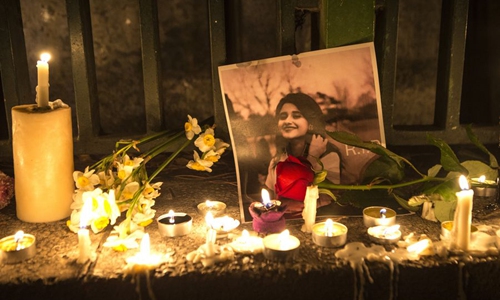Iran weakness shown by protests: experts
By Yang Sheng Source:Global Times Published: 2020/1/15 0:33:35
US gloats at unrest, but numbers ‘should not be exaggerated’

A picture of a victim is seen among candles during a mourning ceremony for the victims of a Boeing 737 Ukrainian passenger plane crash in Tehran, Iran, on Saturday. Photo: Xinhua
"A good hand" was dealt Iran in handling the US assassination of Major General Qasem Soleimani, but Tehran didn't play it well, and now the situation has turned against itself, revealing flaws in the country's crisis management, analysts said.
Earlier this month, on January 5-7, after the assassination of Soleimani, hundreds of thousands of Iranian demonstrators across the country showed their fury toward the US.
But days later, after Iran admitted to shooting down the Ukraine International Airlines Boeing 737 that caused 176 deaths, protests erupted against the Iranian authorities and military forces.
Hua Liming, a former Chinese ambassador to Iran, told the Global Times Tuesday that "Iran actually had a good hand at the beginning, when the world showed sympathy to it and its people were united by anti-US fury, but it messed up."
At first when the airliner crashed, the government, media and leaders all denied any responsibility.
Two days later, an Islamic Revolution Guards Corps (IRGC) aerospace commander said the force took "full responsibility."
On Saturday, Iranian President Hassan Rouhani said the missiles were fired "due to human error."
The crash was an "unforgivable mistake," the president said.
The resulting protests arose in the region of Sharif University of Technology, Amirkabir University of Technology and the University of Tehran, Zhu Ning, bureau chief of the Middle East Office in Tehran of the Shanghai newspaper Wenhui Daily, told the Global Times Tuesday.
"The main reason was that among the 176 passengers killed in the incident, some were students of these universities and so it is totally reasonable for the students to initiate protests to express their sadness and anger," Zhu said.
The protests started Saturday and peaked Sunday, he noted. The participants numbered no more than 2,000 and the protest did not impact other parts of Tehran, Zhu said.
By Tuesday morning, no protester could be found on the streets, he noted.
Yin Gang, an expert on Middle East studies at the China Academy of Social Sciences in Beijing, said that "unreliable reports on the 80 casualties of US troops after the missile strikes and the crash of the Ukrainian airliner seriously damaged the IRGC's image and credibility among the people. The conflicts between the IRGC and the government were uncovered."
Hua noted that the horrible mistake showed the IRGC was to some extent out of control, as it could act indecently and keep its own secrets from other governmental departments, the president of the country, and even the supreme leader.
Wenhui Daily correspondent Zhu asserted that the scale of the protests initiated by students "should not be exaggerated."
Western media, especially the US media, and the US government would love to hype and use the incident, he told the Global Times.